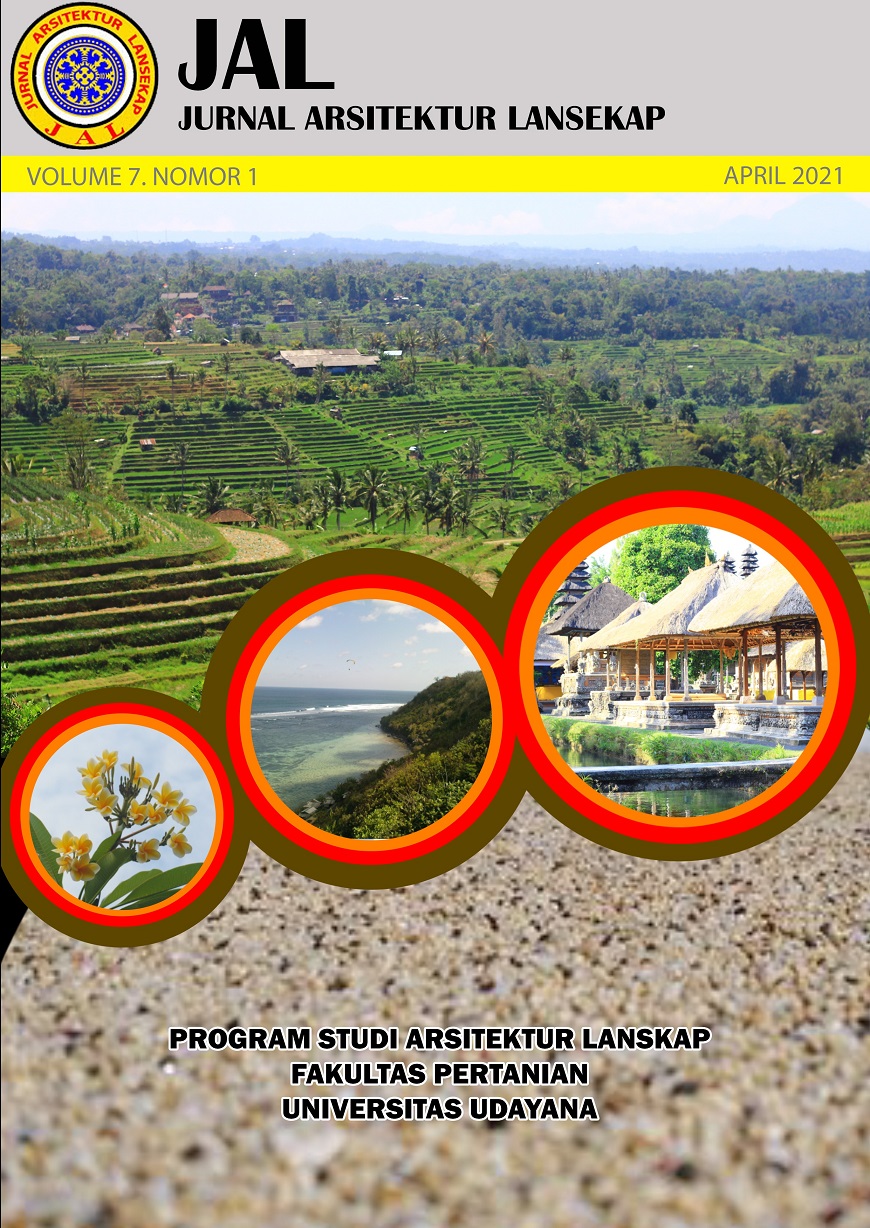Identifikasi morfometri dan pola ruang taman setra di Kecamatan Kuta Utara, Kabupaten Badung, Provinsi Bali
Abstract
Bali island has three types of garden. One of garden’s types that exist in Bali is setra. Setra garden in Bali had been used for spiritual ceremonies like Ngaben. There were more than 1500 setra gardens that had not been yet identified in Bali. Therefore, identifying, collecting data, and mapping of setras garden were needed in analyzing the setras. Setras garden in which located in North Kuta sub-district was chosen in this research because there was not any database yet which was related to the setras especially for its space pattern and morphometry. This research aimed to identify the morphometry, space pattern, factors that affecting space pattern, and utilization of the setras in North Kuta sub-district. The research method used was survey method. This research used descriptive qualitative, and quantitative analisys. In the results, this research found that Kerobokan traditional village had the highest percentage number of setra garden which was 38,1%. Setra Tuka was located in the higest elevation (122,34 msal), while the 80% of setras was in the flat topography. The average area of setras garden in North Kuta was about 0,12 Ha. Direction of centre, and southeast was the most setras position (19%). The whole setras garden in North Kuta applied Tri Mandala concept as its space pattern and all of its space pattern was affected by tradition factor. For setras additional utilization, Caru and Ngereh have the highest percentage, while Ngelungah and Ngelangkir is more attractive activity for tourism.
Downloads
References
BMKG. 2019. Pelayanan Jasa Informasi Klimatologi. BPS Kabupaten Badung. 2019. Kecamatan Kuta Utara Dalam Angka (B. K. Badung (ed.)). BPS Kabupaten Badung.
Fajarini, U. 2014. Peranan Kearifan Lokal Dalam Pendidikan Karakter. Sosio Didaktika: Social Science Education Journal 1(2):123–124.
Gelebet, I. N., Meganada, I. W., Yasanegara, I. M., Sutriya, I. M., & Surata, I. N. 2002. Arsitektur Tradisional Daerah Bali. Badan Pengembangan Kebudayaan dan Pariwisata Bali.
Hastuti, K., Hidayat, E. Y., & Rahmawan, E. 2013. Purwarupa Tangible Cultural Heritage Documentation Berbasis Database Multimedia. Jurnal Techno.Com 12(4):188-197.
Namoua, F., Manengkey, H. W. K., & Rampengan, R. M. 2017. Morfometri Lereng Gisik Di Pantai Tumpaan Kecamatan Tumpaan Kabupaten Minahasa Selatan. Jurnal Pesisir Dan Laut Tropis 1(2):14-19.
Noviasi, N. K. P., Waleleng, G. J., & Tampi, J. R. (2015). Fungsi Banjar Adat Dalam Kehidupan Masyarakat Etnis Bali Di Desa Werdhi Agung, Kecamatan Dumoga Tengah, Kabupaten Bolang Mongondow Provinsi Sulawesi Utara. Jurnal Acta Diurna IV(3):1-10.
Puspa, I. A. T., & Saitya, I. B. S. (2019). Ngaben sebagai Daya Tarik Pariwisata. Jurnal Ilmiah Pariwisata Agama Dan Budaya 4(1):37-45.
Sawitri, Y., Hidayat, W., & Nurseto, S. (2013). Pengaruh Kualitas Produk, Promosi, Faktor Sosial Dan Faktor Psikologi Terhadap Keputusan Pembelian Sepedamotormatic Yamahamio (Studi Pada Yamaha Agungmotor Semarang). Journal of Social and Politic 2(2):1-9.
Sudjana. (2002). Metode Statistika. Tarsito.
Sugianthara, A. A. G., Sarwadana, S. M., Lila, I. K. A., & Sudarsana, A. A. G. D. (2017). Identifikasi dan Morfometri Taman Setra di Kecamatan Ubud. Jurnal Arsitektur Lanskap 3(1):87–88.
An author who publishes in the Jurnal Arsitektur Lansekap (JAL) agrees to the following terms:
- Author retains the copyright and grants the journal the right of first publication of the work simultaneously licensed under the Creative Commons Attribution-ShareAlike 4.0 License that allows others to share the work with an acknowledgement of the work's authorship and initial publication in this journal
- Author is able to enter into separate, additional contractual arrangements for the non-exclusive distribution of the journal's published version of the work (e.g., post it to an institutional repository or publish it in a book) with the acknowledgement of its initial publication in this journal.
- Author is permitted and encouraged to post his/her work online (e.g., in institutional repositories or on their website) prior to and during the submission process, as it can lead to productive exchanges, as well as earlier and greater citation of the published work (See The Effect of Open Access).
Read more about the Creative Commons Attribution-ShareAlike 4.0 Licence here: https://creativecommons.org/licenses/by-sa/4.0/.







